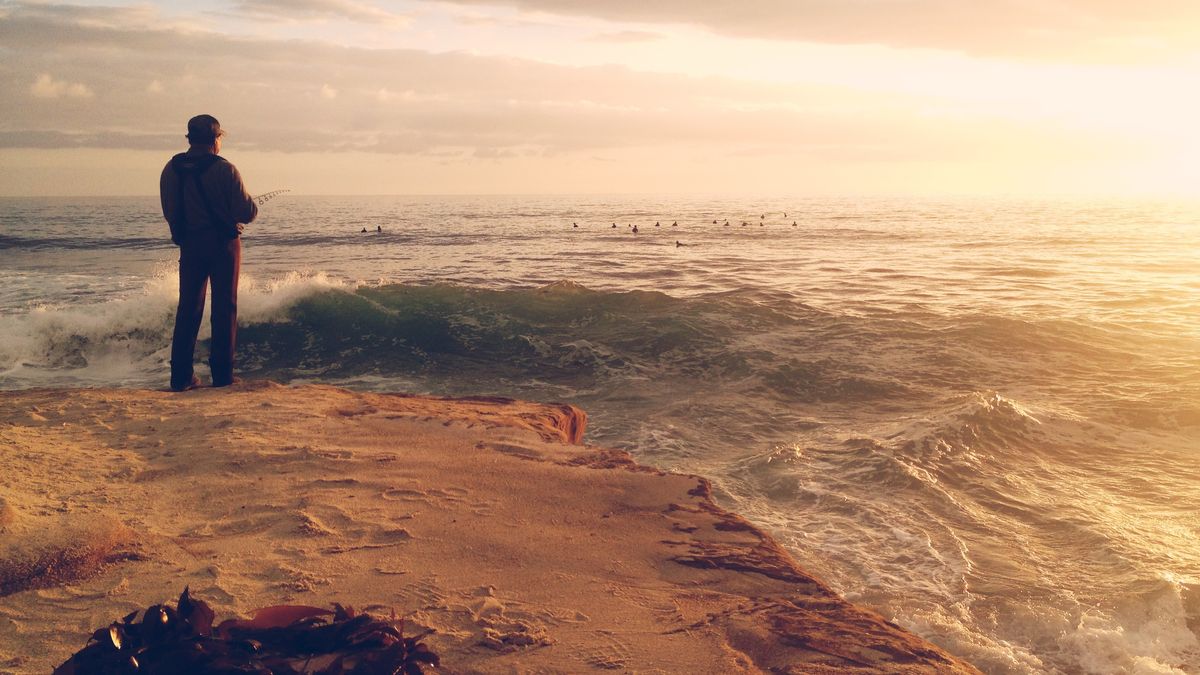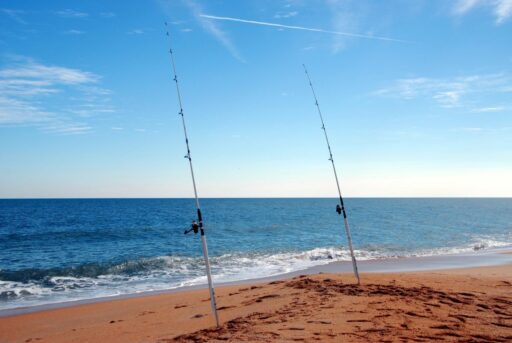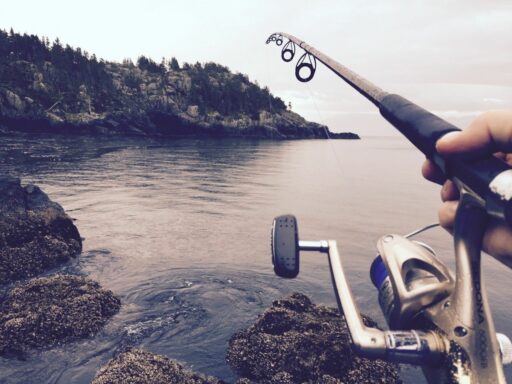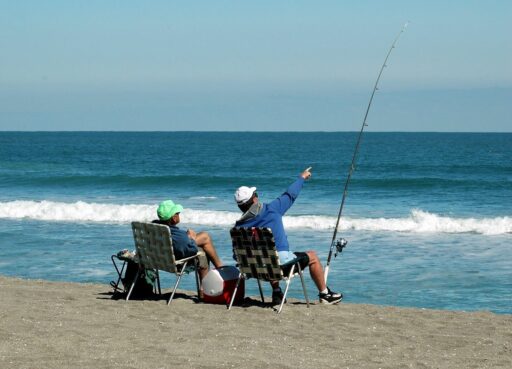Surf fishing is a popular coastal activity that requires the right equipment for success, and one of the most critical pieces of gear is the surf fishing rod. The length of the rod can significantly impact casting distance, control, and the type of species targeted. This article will guide you through the process of choosing the ideal length for your surf fishing rod, taking into consideration various factors such as surf conditions, targeted species, and personal fishing style.
Key Takeaways
- Surf fishing rod length is crucial for casting distance and accuracy, with options ranging from 7 to 12 feet to suit different fishing styles and surf conditions.
- Matching the rod length to the surf conditions and targeted species can significantly enhance your fishing experience and increase your chances of success.
- Rod power ratings, from light to extra heavy, are essential to consider as they determine the strength of the rod and the size of the fish it can handle.
- The synergy between rod and reel is important; pairing the right reel with your surf rod, like a Daiwa BG or Saltist Spinning Reel, can optimize performance.
- Safety and environmental considerations, such as Proposition 65 warnings and eco-friendly fishing practices, should be taken into account when selecting fishing gear.
Understanding Surf Fishing Rod Specifications

The Importance of Rod Length
The length of your surf fishing rod is a critical factor that can significantly influence your fishing experience. Choosing the right rod length is essential for casting distance, accuracy, and maneuverability. Surf fishing rods are available in a variety of lengths, typically ranging from 7 to 12 feet, to accommodate different fishing styles and environments.
- Shorter rods (7-9 feet) offer greater control and are ideal for fishing in crowded areas or where space is limited.
- Medium-length rods (9-11 feet) provide a balance between casting distance and control, suitable for a range of surf conditions.
- Longer rods (11-12 feet) excel in casting distance, allowing anglers to reach deeper waters where fish may be schooling.
It’s important to match the rod length with the surf conditions and the species you’re targeting. A longer rod may be necessary to cast beyond the breaking waves, while a shorter rod could be more effective for quick, short casts in calmer waters. Remember, the right choice will enhance your ability to present bait effectively and handle the fish once hooked.
Deciphering Rod Power Ratings
Understanding the power rating of a surf fishing rod is crucial for matching your gear to the intended fishing conditions and targeted species. Rod power refers to the rod’s strength and its ability to handle different line and lure weights. It’s a key factor in determining how well the rod will perform with various surf fishing rigs.
Rod power is categorized from light to heavy, with each category suited to different fishing scenarios:
- Light: Ideal for smaller fish and calmer waters.
- Medium: Versatile for a range of species and conditions.
- Medium Heavy: Good for larger fish and rougher waters.
- Heavy: Best for big game fish and heavy surf.
Matching the correct rod power to your fishing needs can significantly enhance your casting accuracy and the overall fishing experience.
When selecting a rod, consider the type of fish you’re targeting and the conditions you’ll be fishing in. For example, a heavy power rod may be necessary for casting large baits in strong surf, while a medium power rod could be more appropriate for a variety of situations.
Guide Types and Reel Seat Considerations
When selecting a surf fishing rod, the type of guides and the reel seat are crucial components that can greatly affect your fishing experience. Guide types vary widely, with options like the Fuji SiC ring offering superior heat dissipation, ideal for heavy drags or large fish. The material and design of the guides influence not only the rod’s sensitivity but also its overall durability.
Reel seats must be chosen with care to ensure a comfortable and secure fit for your reel. For instance, the ergonomic Fuji DNPSD Deluxe Ergonomic Spinning Reel Seat is a popular choice among anglers for its comfort and compatibility with almost any spinning reel. It’s essential to have a reel seat that fits ‘just right’ over the tape bushings, neither too tight nor too loose, to maintain optimal control and sensitivity.
Proper alignment of the guides with the reel seat is paramount. Once all guides are wrapped on, they should be checked for alignment before securing the rod tip with glue. This ensures a straight and true cast every time.
Remember to check the guides and reel seat for signs of wear or damage regularly, as these are points of high stress and frequent contact. A well-maintained rod will provide a better fishing experience and last many seasons.
Selecting the Ideal Rod Length for Surf Fishing

Short vs. Long Rods: Pros and Cons
When choosing the length of a surf fishing rod, anglers must weigh the advantages and disadvantages of both short and long rods. Short rods, typically ranging from 7 to 9 feet, offer greater maneuverability and are easier to handle, making them ideal for fishing in crowded areas or where space is limited. They also facilitate more accurate casting at short distances.
On the other hand, long rods, which can extend from 10 to 12 feet, allow for longer casting distances, enabling anglers to reach deeper waters where fish may be schooling. These rods also provide better leverage when fighting larger fish, but they can be more challenging to control, especially in windy conditions.
The choice between a short and long rod ultimately depends on the specific conditions of the surf, the species targeted, and the angler’s personal preference and skill level.
Here’s a quick comparison of the two:
-
Short Rods (7-9 ft):
- Easier to handle
- More accurate for short casts
- Better for crowded spots
-
Long Rods (10-12 ft):
- Longer casting distance
- Better leverage for big fish
- Can be difficult to manage in wind
Matching Rod Length with Surf Conditions
The surf conditions you face will significantly influence the ideal length of your surf fishing rod. Calm conditions with minimal wave action often allow for shorter rods, which can provide greater accuracy and ease of handling. Conversely, rougher seas with larger waves and stronger currents may necessitate longer rods, which offer increased casting distance and better line control over the breakers.
- Calm Conditions: Shorter rods (7-9 feet)
- Moderate Conditions: Medium-length rods (9-11 feet)
- Rough Conditions: Longer rods (11-12 feet)
Matching your rod length to the surf conditions not only enhances your fishing experience but also increases your chances of success. It’s a balance between control and casting distance, tailored to the environment you’re fishing in.
Remember, the right rod length is also about personal comfort and your ability to manage it over extended periods. Expert anglers, like those quoted in the Santa Cruz Sentinel, often have personalized setups that reflect their experience and the specific conditions they target.
Optimal Rod Length for Targeted Species
When targeting specific species in surf fishing, the rod length can be critical to your success. Different species require different casting distances and bait presentations, which are directly influenced by the rod length. For instance, a longer rod will provide greater casting distance, which is beneficial when fishing for species that tend to stay farther from shore.
Here’s a quick reference guide to help you match rod length with common targeted species:
- 7-9 feet: Ideal for smaller species and fishing close to shore.
- 9-11 feet: Versatile range for a variety of species, both close to the shore and at moderate distances.
- 11-12 feet: Best for reaching distant fish or when fishing in deep waters.
It’s also important to consider the structure and conditions of the fishing environment. A shorter rod may be more manageable in tight spaces or when dealing with strong undercurrents. Conversely, a longer rod can be advantageous in open areas with minimal obstructions. Always align your rod choice with the surf conditions and the specific fishing techniques you plan to use.
Matching Rod Power to Your Fishing Needs

Understanding the Different Power Categories
When selecting a surf fishing rod, understanding the different power categories is crucial. Rod power is a critical factor that determines the rod’s strength and its suitability for various fishing conditions and species. It is directly related to the recommended line and lure ratings, and varies by the style of the rod. For instance, a Medium Heavy inshore rod is not the same as a Medium Heavy surf rod.
Surf fishing rods are available in a range of power ratings, typically categorized as Medium, Medium-Heavy, and Heavy. Each category serves a specific purpose and is tailored to different fishing tactics and target species. Here’s a quick guide to help you understand the differences:
- Medium (M): Ideal for smaller species and lighter lures. Offers a good balance of sensitivity and strength.
- Medium-Heavy (MH): Versatile for various species, suitable for heavier lures and moderate surf conditions.
- Heavy (H): Best for large species and heavy surf conditions. Provides maximum strength for big game fishing.
Choosing the right power for your surf fishing rod can enhance your casting accuracy and improve your overall fishing experience. It’s important to match the rod power with the intended use to ensure optimal performance and durability.
The Role of Rod Power in Casting and Retrieval
The power of a surf fishing rod significantly influences your casting distance and the efficiency of your retrieval. A rod with the right power rating enhances the angler’s control and responsiveness during the cast and when reeling in a catch. For instance, a Medium-Heavy surf rod offers a balance between casting distance and the strength needed to handle larger fish, while a Heavy power rod is more suited for battling the biggest species from the surf.
When selecting a rod for surf fishing, consider the type of lures or bait you will be using. The power of the rod should complement the weight of your tackle to ensure optimal performance.
Rod power also affects the action of lures during retrieval. A rod with too much power can hinder the natural movement of lighter lures, while one that’s too light may not provide the necessary force for larger lures. Here’s a quick reference to match rod power with lure weight:
- Light: Suitable for lures up to 1/4 oz
- Medium: Ideal for lures between 1/4 oz and 3/4 oz
- Medium-Heavy: Best for lures between 3/4 oz and 1 oz
- Heavy: Designed for lures over 1 oz
Understanding the synergy between rod power, casting, and retrieval will not only improve your fishing technique but also increase your chances of a successful catch.
Choosing the Right Power for Surf Fishing Rigs
Selecting the appropriate power for your surf fishing rig is crucial for a successful outing. The power of the rod should match the typical size and strength of the fish you’re targeting. For lighter species, a medium-light to medium power rod is often sufficient, providing the sensitivity needed for detecting subtle bites. Conversely, larger species demand a medium-heavy to heavy power rod to withstand the fight and prevent breakage.
When considering the power of your surf fishing rod, also think about the weight of the lures or bait you will be using. Heavier tackle requires a rod with more backbone to cast effectively. Here’s a simple guide to help you choose:
- Light Power: Ideal for small bait and light lures, targeting smaller fish.
- Medium Power: Versatile for various bait sizes, suitable for a range of medium-sized species.
- Medium-Heavy to Heavy Power: Necessary for large bait and heavy lures, targeting larger, stronger fish.
Remember, the goal is to create a balance between the rod power and the fishing conditions to optimize your chances of a catch. Factors such as surf conditions and the presence of structure should influence your choice.
Ultimately, the right power for your surf fishing rig will enhance your casting distance, accuracy, and the overall enjoyment of your fishing experience. It’s about finding that sweet spot where the rod’s power aligns with the surf conditions, bait size, and the species you aim to hook.
The Synergy of Rod and Reel Combos

Benefits of Spinning Combos for Surf Fishing
Spinning combos are a popular choice among surf anglers for their ease of use and versatility. Spinning reels are particularly well-suited for beginners, as they are less prone to tangling and can be mastered with minimal practice. The combination of a spinning rod and reel offers a balanced setup that can handle a variety of surf conditions and targeted species.
When selecting a spinning combo for surf fishing, consider the construction materials, such as graphite composite blanks and aluminum oxide guides, which provide both strength and sensitivity. The spooling system of a spinning reel allows for smooth and efficient casting, essential for reaching the distant waters where fish congregate.
The right spinning combo can significantly enhance your surf fishing experience, offering a blend of power and precision that can make all the difference when casting from the shore.
How to Pair Your Surf Rod with the Right Reel
Pairing your surf rod with the right reel is crucial for a balanced setup that enhances your fishing experience. Select a reel that complements the power and length of your rod to ensure smooth casting and retrieval. For instance, a medium power, 8-foot surf rod pairs well with a spinning reel that has a gear ratio around 5.1:1 and a reel size of 50. This combination allows for versatile fishing techniques, whether you’re soaking bait or throwing metal.
When considering reel types, spinning reels are often favored for their ease of use and ability to handle a wide range of surf conditions. Here’s a simple guide to help you match your surf rod with a spinning reel:
- Ensure the reel’s gear ratio is suitable for the type of lure or bait you plan to use.
- Check the reel size to confirm it can hold enough line for long-distance casting.
- Verify the reel’s drag system can handle the targeted species’ weight and strength.
Remember, a well-matched rod and reel combo can make a significant difference in your surf fishing success. It’s not just about the gear’s capabilities, but also about how they work together to give you control and confidence on the water.
Top Rod and Reel Combos for Surf Fishing
When it comes to surf fishing, the synergy between rod and reel is paramount for a successful outing. Selecting the right combo can make a significant difference in casting distance and fish fighting capabilities. For those seeking the best equipment, the Daiwa Coastal Salt Pro Surf Spinning Rods paired with a Daiwa BG or Saltist Spinning Reel is a formidable choice. These rods are designed for long casting and feature IM-7 Graphite construction, ensuring both strength and flexibility.
The Shakespeare Catch More Fish™ Surf Pier 8 Ft Spinning combo is another excellent option, especially for beginners. It offers a balanced blend of rod length and power, suitable for various surf conditions. Below is a list of some top rod and reel combos, highlighting their key attributes:
- Daiwa Coastal Salt Pro Surf Spinning Rods: Long casting, IM-7 Graphite, Fuji guides.
- Shakespeare Catch More Fish™ Surf Pier 8 Ft Spinning: Ideal for beginners, balanced rod length and power.
- Salt Pro Surf Rods: Great for fast, ripping retrieves, available in multiple lengths and power ratings.
Remember, the best rod and reel combo is one that fits the specific conditions you’ll be fishing in and the species you’re targeting. Factors such as rod length, power, and reel type should be carefully considered to ensure you have the right gear for your surf fishing adventures.
Safety and Environmental Considerations

Navigating Proposition 65 Warnings
When selecting surf fishing gear, it’s crucial to be aware of Proposition 65 warnings. These warnings are designed to inform consumers about potential exposure to chemicals that can cause cancer, birth defects, or other reproductive harm. For surf anglers, this often pertains to the materials used in rods, reels, and tackle.
Proposition 65 requires businesses to provide warnings to Californians about significant exposures to chemicals that cause cancer, birth defects, or other reproductive harm.
Understanding the implications of these warnings is essential, especially when purchasing items that may contain harmful chemicals. Here’s a quick guide to help you navigate these warnings:
- Always check the product label or packaging for the Proposition 65 warning symbol.
- Visit the official Proposition 65 website for detailed information on listed chemicals (www.P65Warnings.ca.gov).
- Consider the frequency and duration of exposure when assessing the risk.
- Look for alternative products that do not carry the Proposition 65 warning if you have concerns.
By staying informed and cautious, you can make safer choices for your health while enjoying the sport of surf fishing.
Eco-Friendly Fishing Practices
Adopting eco-friendly fishing practices not only helps in preserving marine life but also ensures a sustainable future for the sport of fishing. Choosing the right fishing rod is crucial for comfort and success. Consider factors like fishing space, location, and style to select the ideal rod length for better accuracy and leverage.
When selecting gear, it’s beneficial to consider the environmental impact of your choices. For instance, opting for lead-free weights and biodegradable fishing lines can significantly reduce the ecological footprint left behind. Additionally, using circle hooks can minimize harm to fish, promoting catch and release with less injury.
It’s essential to be mindful of the waste generated while fishing. Proper disposal of line snips, bait containers, and other refuse helps protect wildlife and keeps our waterways clean.
By following these simple yet effective guidelines, anglers can contribute to the conservation of our oceans and ensure that surf fishing remains an enjoyable activity for generations to come.
Maintaining Your Gear for Longevity and Performance
Proper maintenance of your surf fishing rod not only extends its lifespan but also ensures peak performance during each outing. Regular inspection and cleaning are crucial to prevent saltwater corrosion and wear. Here’s a simple maintenance routine to follow:
- Clean your rod with fresh water after each use.
- Inspect guides for damage or wear, replacing them if necessary.
- Check the reel seat for stability and apply a protective coat if needed.
- Store your rod in a cool, dry place away from direct sunlight.
By adhering to a consistent maintenance schedule, you can avoid the time-consuming process of a full restoration and keep your rod in top condition.
Remember, a well-maintained rod not only performs better but can also be a source of pride. It’s a reflection of your dedication to the sport and your respect for the equipment that enables your pursuit.
Conclusion
In conclusion, selecting the right length for your surf fishing rod is a critical decision that can greatly impact your fishing experience. Whether you’re casting long distances with Salt Pro Surf Rods or targeting specific species with the best surf fishing rigs, the length of your rod plays a pivotal role. From 7 feet for agility and control to 12 feet for maximum casting reach, the choice depends on your fishing conditions, target species, and personal preference. Remember, there is no one-size-fits-all solution; it’s about finding the balance between rod power, length, and the type of fishing you plan to enjoy. With the insights provided in this article, you’re now equipped to make an informed decision and select a surf fishing rod that will serve you well on your next coastal adventure.
Frequently Asked Questions
What are the key factors to consider when selecting a surf fishing rod?
The key factors include the rod length, rod power, guide types, reel seat, and the type of fishing rig you plan to use. You should also consider the surf conditions, targeted fish species, and the type of bait or lures you will be using.
How does rod length affect surf fishing?
Rod length can impact casting distance and accuracy. Longer rods are typically better for casting further distances, which is beneficial in surf fishing to reach beyond the breaking waves. Shorter rods offer more control and are easier to handle, which can be advantageous in certain surf conditions or when targeting specific species.
What does rod power mean and why is it important?
Rod power refers to the rod’s strength or lifting power and is directly related to the recommended line and lure ratings. It’s important because it affects the rod’s ability to cast certain weights and handle the fight with different sizes of fish. The right rod power ensures balanced performance and can prevent equipment failure.
How do I match my surf rod with the right reel?
To match your surf rod with the right reel, consider the reel’s size, gear ratio, and handle position. The reel should balance with the rod in terms of weight and capacity, and it should have a gear ratio suitable for the type of retrieval you plan on doing. Also, ensure the reel handle can be comfortably used in either the right or left hand.
What are some of the best surf fishing rigs to use?
The best surf fishing rigs depend on the target species, surf conditions, and bait presentation. Popular rigs include the Carolina Rig for its versatility and ability to present bait naturally. However, there are many other rigs to choose from, and the ideal choice will vary based on the specific circumstances of your fishing trip.
What safety and environmental considerations should I be aware of when surf fishing?
Be aware of Proposition 65 warnings regarding exposure to harmful chemicals, such as lead in fishing gear. Always practice eco-friendly fishing by using sustainable practices, avoiding disturbance to local wildlife, and maintaining your gear properly to reduce waste and ensure safety and peak performance.





